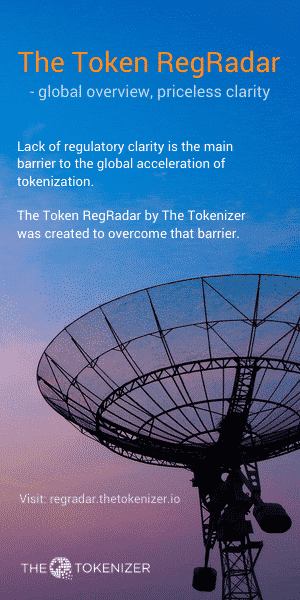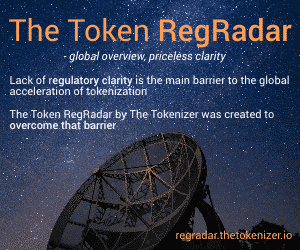By Ryan Bethem, COO, Chintai Ltd.
The rise of decentralized finance (Defi) applications is in full swing. Every protocol from Ethererum to EOS has seen an explosion of new DeFi projects trying to capitalize on the hype. While some projects have shown credibility, there have been numerous hacks, critical bugs and exit scams that have resulted in major losses for investors.
While it’s likely that a small number of credible projects will emerge from the recent DeFi craze, we believe regulated DeFi has a much larger role in the transformation of the global financial system. It’s commonly asserted that “regulated DeFi” is an oxymoron. But if architected properly, regulation can play to the greatest strengths of DeFi and yield a constellation of unique benefits for all market participants.
Everyone can win with the best of both worlds
Regulated DeFi is the middle ground that provides a trusted venue that is necessary for both capital markets and cryptocurrencies to be legitimately issued and traded.
By applying on-chain regulatory controls to DeFi, custody can remain with the investor, bad projects can be filtered out to eliminate scams, credible projects can issue a variety of assets without traditional administrative overhead, money laundering is negated, bugs in contracts will not result in permanent loss of funds with no recourse and capital parked in the traditional financial system can begin to deploy into the world of digital assets.
Because regulatory breach is inevitable with virtually every DeFi application, the majority of assets and capital that exists in the traditional financial system will not enter the decentralized space. In fact, billions are spent by asset managers on compliance. DLT can dramatically reduce those costs with more efficient systems. But the point is refusal of regulation means missing the larger market opportunity.
The market capitalization of all crypto assets does not eclipse $1trillion. Securities, fixed income, equities and so on exceeds $100s of trillions. And while many cryptocurrencies are often designed without regulation in mind, the rails in which they exist are in many cases going to be fenced in by on/off ramps that must comply with regulators. For example, the Financial Action Task Force (FATF) standard known as the “travel rule”, requires virtual asset providers (VASPs) to provide an audit trail of user data during inter-VASP transfer. This is one of many examples of how digital assets will be regulated indirectly, even if regulation is not applied directly into the protocol or application level.

Why do regulations traditionally exist?
The existence of regulation can be distilled to two main purposes. Blocking funding of criminals and “terrorist” organizations. And protecting investors from fraud and bad investments.
Money Laundering
Criminals need to launder money if they want to use it without becoming known to relevant authorities. Terrorists rely on laundering money to fund their goals. Most governments try to restrict the flow of funds to criminals and terrorists with two basic strategies. Know your customer (KYC) and transaction monitoring.
KYC
KYC involves proving your identity to a given platform or financial institution. Usually this is achieved by providing identifying information such as an official ID. Depending on the platform and nature of desired activities you may be required to provide extensive information. Examples are proving a source of wealth or a list of family members.
This information is used to ensure that you are not a known criminal or terrorist. It’s also used to determine whether or not there’s a chance that you will launder money. This includes how you might launder money given the opportunity.
For example, if you prove that you earn $50K per year, and subsequently begin investing with $3M, flags would be raised about the discrepancy. Either someone is giving you money to launder, or you are earning more than you can legally prove.
By integrating KYC and user details with DLT within a regulated venue, all information can be privately stored on-chain with a transparent, immutable audit trail. KYC is also used to perform basic compliance checks and apply controls where necessary, which results in substantial efficiency gains for issuers (compliance liability is one of the biggest concerns of an issuer). This system allows both protections and trust that market participants need, while helping eliminate fraud.
Transaction Monitoring
Transaction monitoring is a tool that combs patterns in user behavior on a given venue to indicate possible money laundering. Making very large transactions that are misaligned with expectations for a given account size, or making many small transactions to bypass a system check are simple examples of common money laundering techniques.
Without proper controls to ensure money is not being laundered, financial institutions with integrity will not involve themselves with a given trading and issuance venue. This is because investors can potentially trade with market participants who are using a given platform for malicious activity. In fact, transaction monitoring is a basic compliance requirement for any asset manager. Transaction monitoring in legacy systems involves very expensive, and often manual processes for monitoring and reporting to the authorities.
DLT can evolve transaction monitoring by providing a transparent, immutable audit trail of transactions. This audit trail can be used to automate reports and apply controls for both non-malicious and malicious activities by smart contract.
For example, if a system check determines a transaction falls into the category of potential money laundering, an STR can be automatically submitted for further evaluation. Furthermore, controls can be applied to ensure eligibility of investors trading and accessing a given asset. (KYC information is stored and used by smart contracts to automatically apply jurisdictional controls where necessary).
This is especially important for issuers since they are liable for making sure that only eligible investors have possession of assets post distribution. Reducing this administrative overhead not only results in higher margins for issuers, but means the barrier to entry for small to midsize enterprises (SME’s) is much lower than the current, sometimes predatory, outlets.
Investor Protections
The degree that investors should be protected from “bad investments” is contentious. At one end of the spectrum there is an argument that individuals should be responsible for their own investment choices, and no entity should have the power to be a “gatekeeper”. However without eligibility and sophistication checks, investors are vulnerable to the common problems we see in DeFi today (hacks, bugs, ponzis, scams, etc) and lack reliable recourse.
To the contrary, where very restrictive regulation and controls exist there is a tendency to monopolize issuance outlets. This results in restricted access for raising capital. There is an optimal balance that involves regulatory controls that reduce risks for investors, ensuring legitimacy of a given investment or company, and expanding the ability of firms to rapidly and cost efficiently conduct issuance.
Macro Implications Of DLT Issuance
By tapping into the efficiency gains of DLT in a regulated decentralized finance venue, cost barriers can be significantly lowered for issuers of all sizes. Lowering cost barriers for issuers will democratize the ability of credible companies to raise capital. This results in more competition and better products that can (hopefully) meaningfully impact quality of life.
Additionally, since the bulk platforms that service issuance products are virtually monopolized by large corporate banks, even credible projects can have a difficult time paying service fees. This boxes out competition and creates anti-competitive markets.
Regulated DeFi is the foundation for the emergence of numerous issuance service providers (like Chintai) to enable businesses to gain low cost access to primary markets. Consequently, the current “gatekeepers” would not be able to maintain an anti-competitive grip on issuance outlets and more companies could raise much needed capital to grow their businesses. Rather than restrictive fees being the barrier to access, credibility will determine a company’s ability to raise.
Conclusion
Regulated decentralized venues built on high-performance technology are poised to become the rails that will be used for the much larger market opportunity in DeFi. It’s a matter of time before the transition in capital markets occurs.
EOS and companies like Chintai can emerge as the leading venues to transform capital markets and market access for numerous investor types and issuers of all sizes. While we believe that there is a place for the unregulated world of cryptocurrencies, our goal is to provide a middle ground that enhances investor protections, market transparency, trust and ultimately the success of businesses and their ability to deliver meaningful products to consumers.
Image by Gerd Altmann from Pixabay
Related Readings:
Why Defi in Crypto will have Exponential Growth!
Swiss Blockchain Academy launches «SchwyzTech – Blockchain Innovation»
You Might also Like
















Great impacts on your article